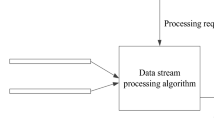Abstract
In order to solve the problem of high energy consumption caused by node overload in complex network flow, a simulation load separation control algorithm based on complex network flow is proposed. According to the characteristics of complex network flow, combined with the characteristics of traffic in the network, a tree combined classifier is designed to discretize the complex network, analyze the micro dynamics of nodes in the network, and simulate the load division of nodes in complex network flow by dividing simulation load, evaluating node bandwidth, transferring overload nodes, and controlling the tree combined classifier. The experimental results show that the designed discrete control algorithm has the advantages of low cost, good load balancing, low energy consumption, and good simulation load discrete control performance.







Similar content being viewed by others
Availability of data and material
The datasets used and/or analyzed during the current study are available from the corresponding author on reasonable request.
Code availability
Not applicable.
References
Qureshi, S. M., Purdy, N., Mohani, A., et al. (2019). Predicting the effect of nurse–Patient ratio on nurse workload and care quality using discrete event simulation. Journal of Nursing Management, 27(5), 971–980.
Jiang, X. S., Tian, S. P., Zhang, T. L., et al. (2019). Stability and stabilization of nonlinear discrete-time stochastic systems. International Journal of Robust and Nonlinear Control, 29(18), 6419–6437.
Sylvie, C. B., Peter, B., Bryan, M., et al. (2018). Discrete-event simulation modeling unlocks value for the Jansen potash project. Interfaces, 48(1), 45–56.
Lommen, S., Lodewijks, G., & Schott, D. L. (2018). Co-simulation framework of discrete element method and multibody dynamics models. Engineering Computations, 35(3), 1481–1499.
Giulia, P., Andrea, M., Arianna, A., et al. (2018). Design and control of manufacturing systems: A discrete event optimisation methodology. International Journal of Production Research, 56(1–2), 543–564.
Marina, T., Natalia, C., & Anastasia, L. (2020). CMMSE 2019: An explicit algorithm for the simulation of non-isothermal multiphase multicomponent flow in a porous medium. Journal of Mathematical Chemistry, 58(3), 595–611.
Chen, G. J., & He, S. P. (2019). Application of inhomogeneous discrete method to the simulation of transport, agglomeration, and removal of oxide inclusions in a gas-stirred ladle. JOM Journal of the Minerals Metals and Materials Society, 71(11), 4206–4214.
Wang, C., & Zhu, M. (2018). Characterizing dynamic property of air traffic flow time series based on complex network, computer engineering and applications. Computer Simulation, 35(6), 81–85.
Wang, Y. F., Li, Z. X., Quan, L. D., et al. (2018). Cluster synchronization of Markovian complex networks with uncertain transition probabilities. Control and Decision, 33(4), 741–748.
Zhou, D. Y., Hu, F. N., Wang, S. L., & Chen, J. (2021). Power network robustness analysis based on electrical engineering and complex network theory. Physica A: Statistical Mechanics and its Applications, 564, 125540.
Li, S., Wu, S. F., Wang, T. F., et al. (2018). Simulation and experimental research on load control and anti-swing of double-beam bridge. Science Technology and Engineering, 39(3), 297–302.
Chen, C., Xiao, M., et al. (2019). A rear-end collision risk evaluation and control scheme using a Bayesian network model. IEEE Transactions on Intelligent Transportation Systems, 20(1), 264–284.
Melicherová, M., Ondrišová, M., & Šušol, J. (2021). Bibliometrics versus altmetrics: Researchers’ attitudes in Slovakia. Iberoamerican Journal of Science Measurement and Communication, 1(1), 002.
Junaid, S., & Ammar, H. (2018). Control-oriented discrete-time large-signal model of phase-shift full-bridge DC–DC converter. Electrical Engineering, 100(3), 1431–1439.
Léchappé, V., Moulay, E., Plestan, F., et al. (2019). Discrete predictor-based event-triggered control of networked control systems. Automatica, 107, 281–288.
Fu, X., Pace, P., Aloi, G., et al. (2020). Topology optimization against cascading failures on wireless sensor networks using a memetic algorithm. Computer Networks (Amsterdam, Netherlands, 1999), 177, 107327.
Borrell, R., Cajas, J. C., Mira, D., et al. (2018). Parallel mesh partitioning based on space filling curves. Computers and Fluids, 173, 264–272.
Delaval, G., Hore, A., Mocanu, S., et al. (2020). Discrete control of response for cybersecurity in industrial control. IFAC-PapersOnLine, 53(2), 1747–1754.
Guerra, T. M., Nguyen, A. T., & Defoort, M. (2019). Control of SISO non-affine-in-control discrete-time systems using Takagi-Sugeno models. IFAC-PapersOnLine, 52(11), 79–84.
Li, G., Chen, X., Pei, T., et al. (2019). Target control of directed networks based on network flow problems. IEEE Transactions on Control of Network Systems, PP(99), 1–1.
Lin, H., & Yang, X. (2020). Dichotomy algorithm for solving weighted min-max programming problem with addition-min fuzzy relation inequalities constraint. Computers and Industrial Engineering, 146, 106537.
Dmitrishin, D., Hagelstein, P., Khamitova, A., et al. (2020). Fejér polynomials and control of nonlinear discrete systems. Constructive Approximation, 51(2), 383–412.
Tiwari, S. P., Koley, E., & Ghosh, S. (2021). Communication-less ensemble classifier-based protection scheme for DC microgrid with adaptiveness to network reconfiguration and weather intermittency. Sustainable Energy Grids and Networks, 26(2), 100460.
Dutta, D., Sil, J., & Dutta, P. (2020). A bi-phased multi-objective genetic algorithm based classifier. Expert Systems with Application, 146(May), 113163.1-113163.25.
Jin, J., Feng, F., Zhang, J., et al. (2020). A novel deep neural network topology for parametric modeling of passive microwave components. IEEE Access, 8, 82273–82285.
Tan, Y., Wu, J., & Zhong, Q. (2020). Complex network. Journal of Physics Conference Series, 1601, 032011.
Kmcma, B., Sks, C., & Pg, D. (2020). Defective texture classification using optimized neural network structure—ScienceDirect. Pattern Recognition Letters, 135, 228–236.
Funding
Not applicable.
Author information
Authors and Affiliations
Corresponding author
Ethics declarations
Conflict of interest
No conflict of interest exits in the submission of this manuscript.
Additional information
Publisher's Note
Springer Nature remains neutral with regard to jurisdictional claims in published maps and institutional affiliations.
Rights and permissions
About this article
Cite this article
Li, X., Xu, S. & Hua, X. Discrete control algorithm of simulation load division based on complex network flow. Wireless Netw 28, 2755–2764 (2022). https://doi.org/10.1007/s11276-021-02728-6
Accepted:
Published:
Issue Date:
DOI: https://doi.org/10.1007/s11276-021-02728-6




